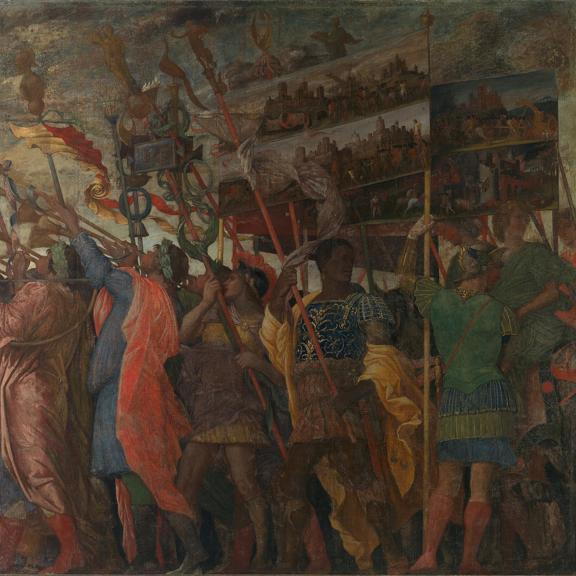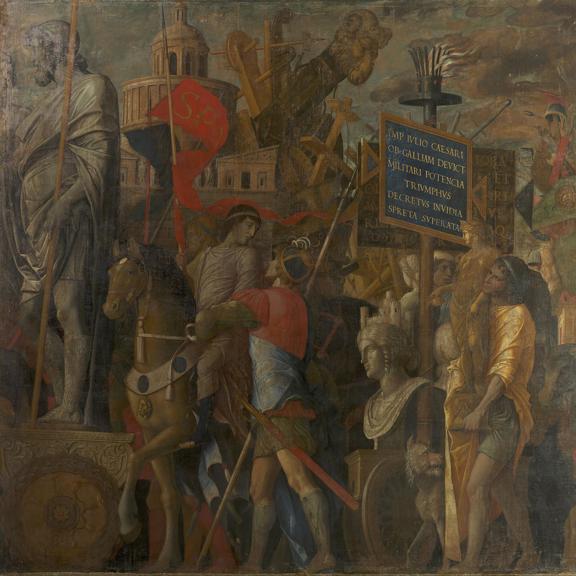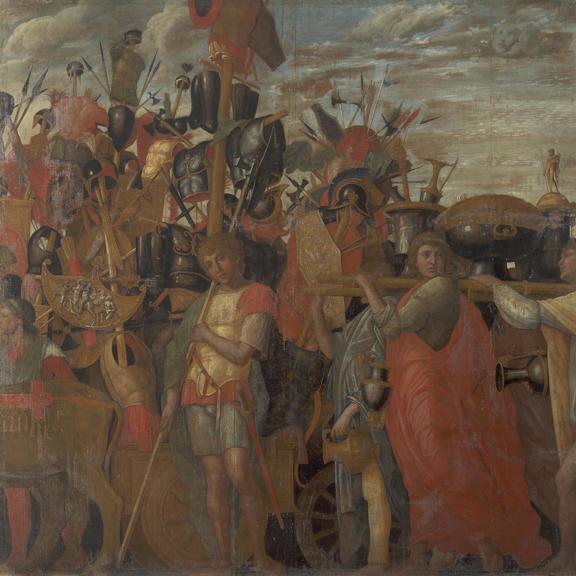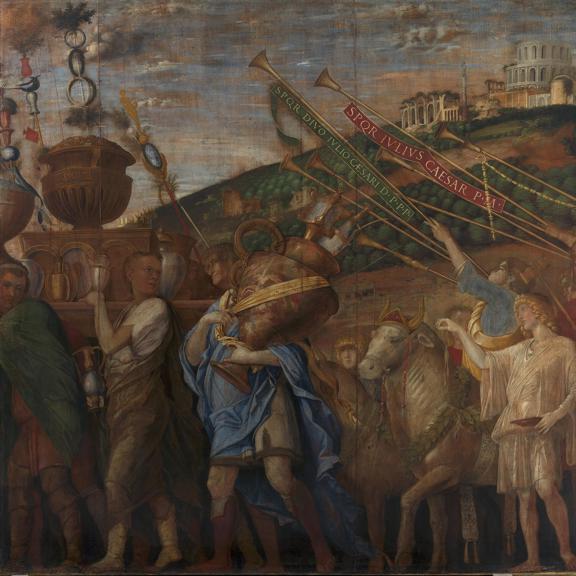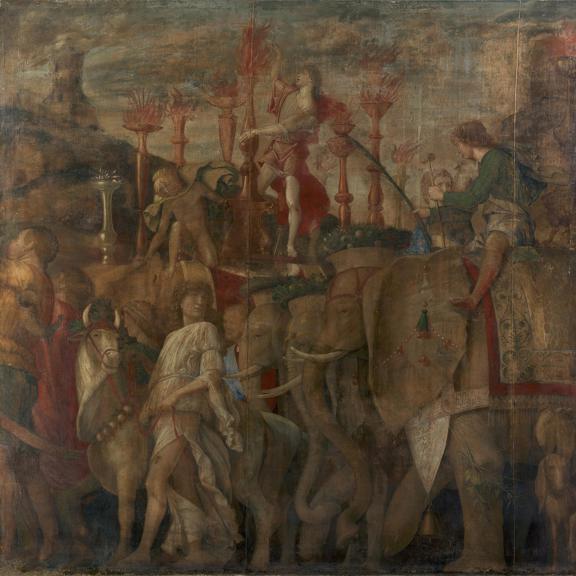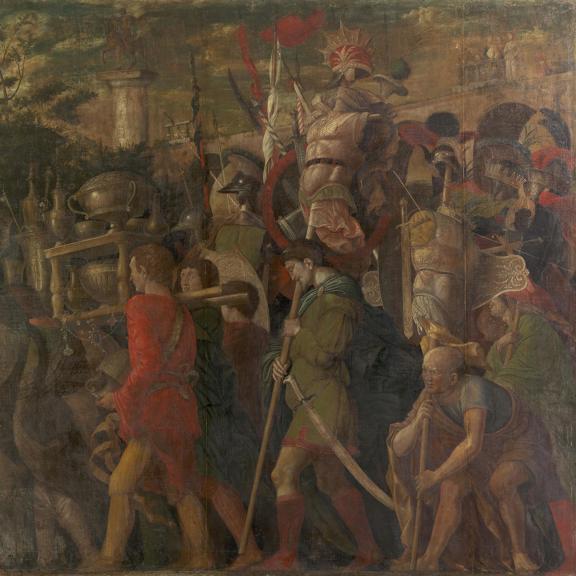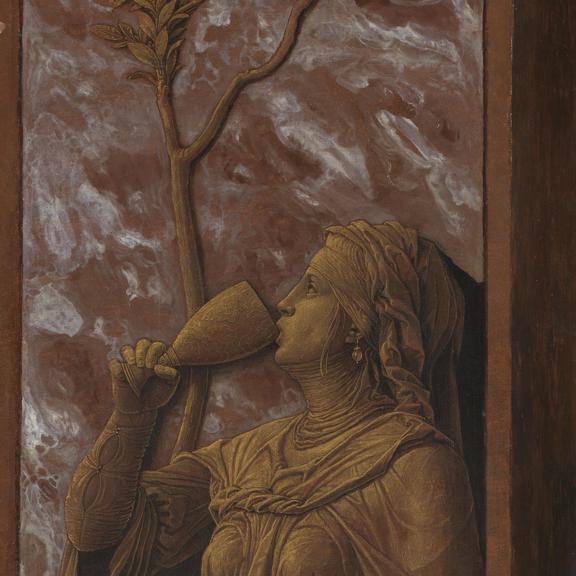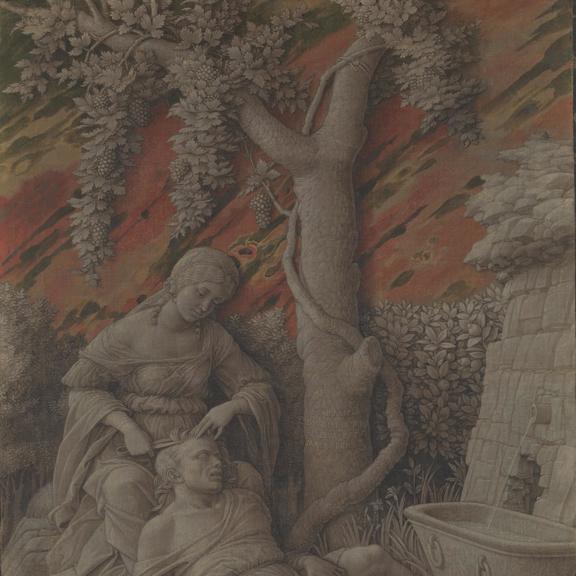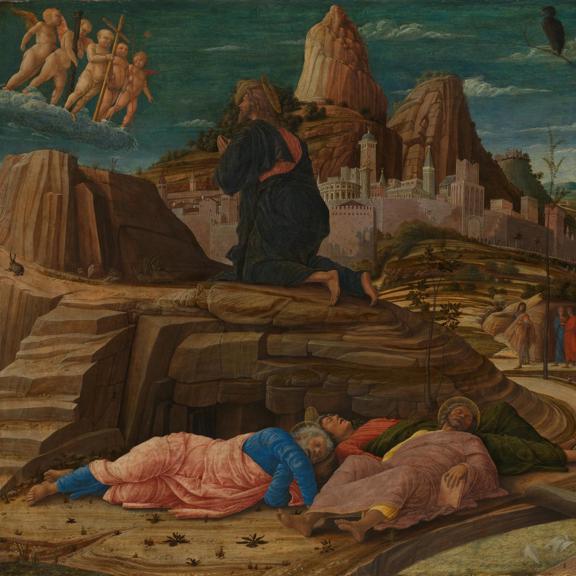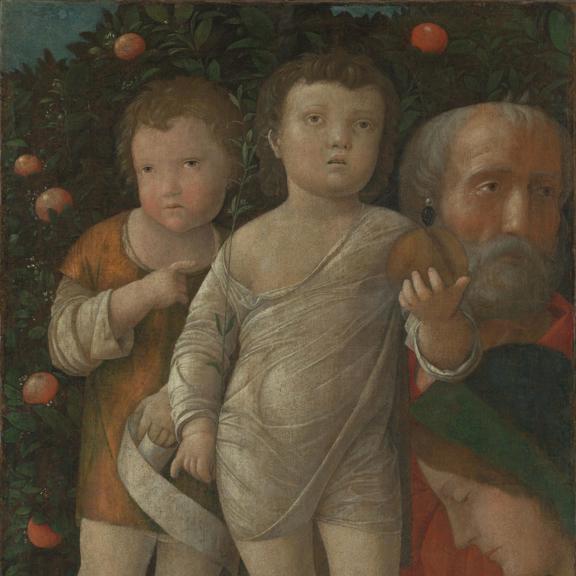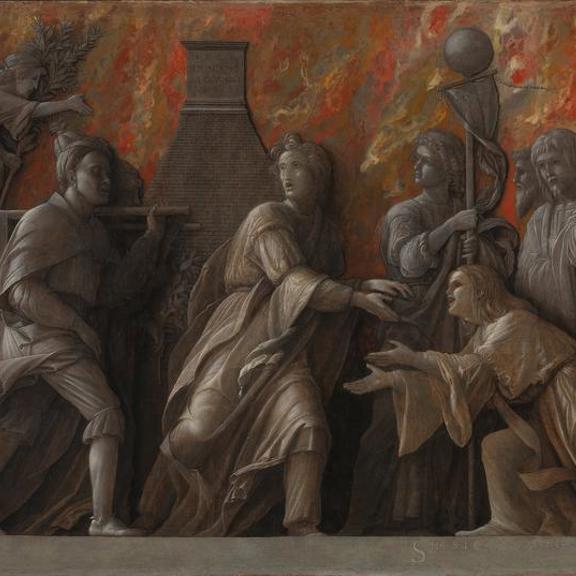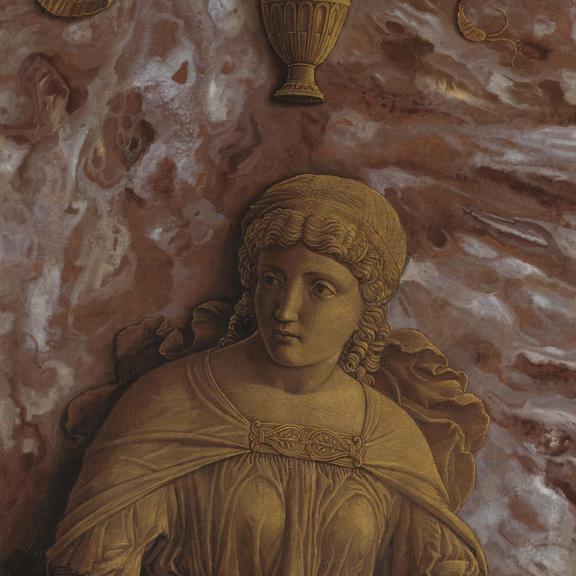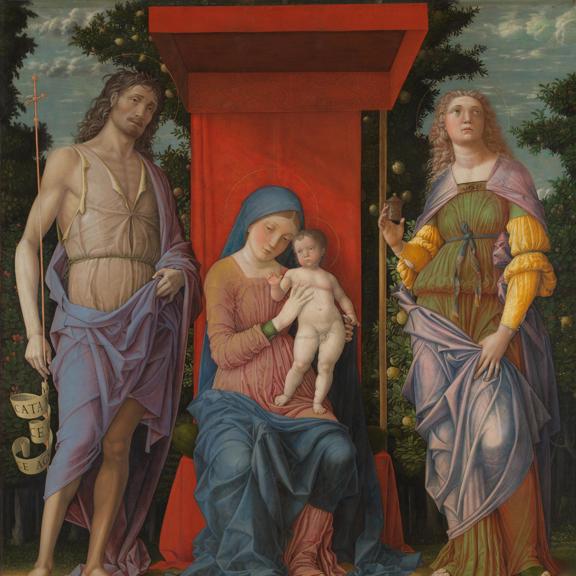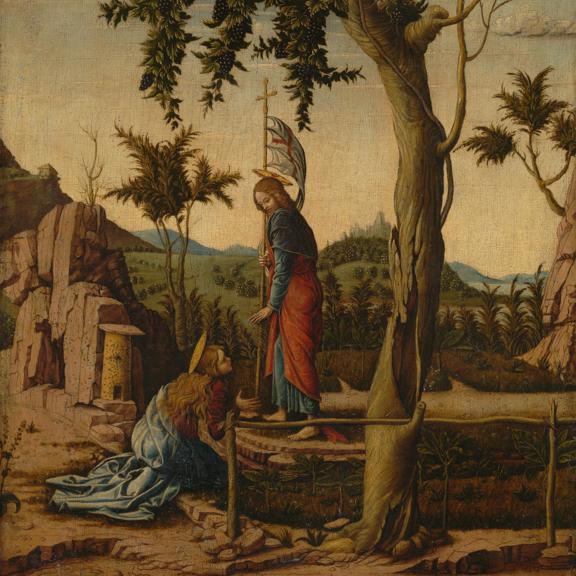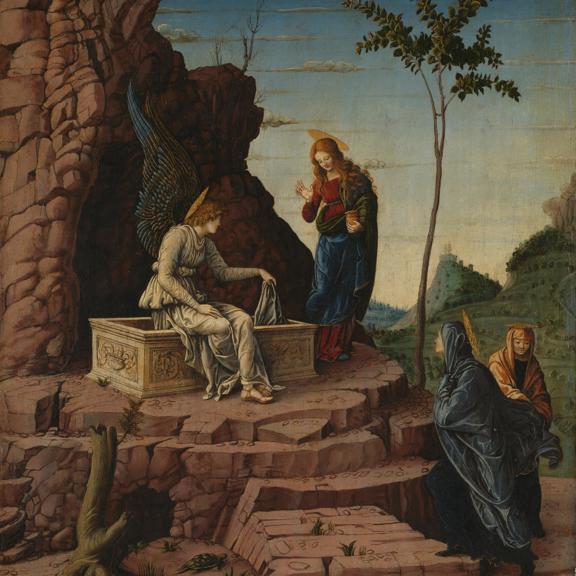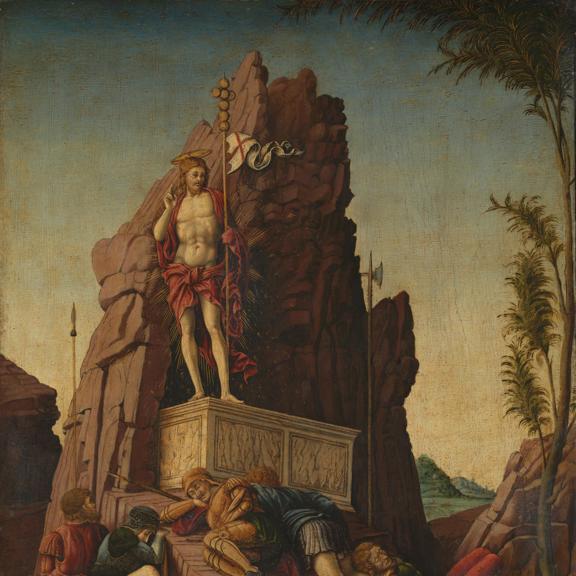Andrea Mantegna, The Triumphs of Caesar: 3, The Trophy Bearers
The Triumphs of Caesar
These are six of the nine monumental canvases known as The Triumphs of Caesar, painted by Andrea Mantegna between the mid-1480s and 1506. They depict a magnificent procession celebrating the victories of the Roman general – and later dictator – Julius Caesar over Gaul between 58 and 50 BC.
Mantegna embarked on this highly ambitious project when he was working as court painter for the ruling Gonzaga family in Mantua. He drew on ancient and contemporary writings for this powerful and sustained evocation of the classical world, as well as the imagery of Roman antiquities, such as friezes and monumental arches.
The Triumphs were acquired by King Charles I of England in 1629, when he purchased many Gonzaga treasures. Considered the jewel in the crown of the king’s paintings, they arrived in England the following year and were hung in Hampton Court Palace.
The Triumphs have since seldom left Hampton Court, but their dedicated gallery is now undergoing refurbishment (completion planned for 2026). Six of the nine are on display in the National Gallery, having been generously loaned by His Majesty the King.
These are six of the nine monumental canvases known as The Triumphs of Caesar, painted by Andrea Mantegna between the mid-1480s and 1506. They depict a magnificent procession celebrating the victories of the Roman general – and later dictator – Julius Caesar over Gaul between 58 and 50 BC.
Mantegna was one of the most classically attuned artists of the fifteenth century. His lifelong passion for ancient Roman art and archaeology was ignited during his formative years in the vibrant university town of Padua, fuelled by the city’s academic climate and its abundance of Roman remains. In 1460 the artist moved to Mantua after having been appointed court painter to Ludovico III Gonzaga (1412‒1478), whose humanist education helped transform the city into a centre of intellectual and artistic distinction. Mantegna’s keen interest in the art of antiquity found great currency amongst the Gonzaga family and their circle, who shared his passion. At the Mantuan court, Mantegna was able to deepen his understanding of the arts of antiquity through encounters with visiting scholars and humanists (such as Leon Battista Alberti), and studying classical objects in the collections of his patrons and at nearby archaeological sites.
In the mid-1480s, Mantegna embarked on the Triumphs of Caesar, the most ambitious project of his career. For this powerful and sustained evocation of the classical world, the artist drew on ancient and contemporary writings, as well as the imagery of Roman antiquities, such as friezes and monumental arches. The painter’s conception of The Triumphs spaces numerous laden carts and figures across nine separate vignettes, uniting them with figures crossing between the canvases to create a single unified procession. The series culminates in the ninth canvas with the figure of the triumphant Caesar himself, shown seated in a high chariot drawn by a magnificent white horse (on view in Hampton Court Palace).
Little is known about the commission of the Triumphs. The series had certainly been begun by the summer of 1486. On 26 August that year, a letter describing the visit of Ercole d’Este, Duke of Ferrara to Mantua, mentioned that the duke had been taken to see ‘the Triumphs of Caesar which Mantegna is painting’, though no indication about what stage the series had reached by this date is given. The complete Triumphs were probably finished shortly before Mantegna’s death in 1506. The canvases were installed in the Gonzaga family’s palace in Mantua but subsequently suffered weather damage and underwent numerous restoration campaigns. Despite their complex physical history, the works retain their vigour and grandeur, attesting to Mantegna’s powers of invention.
Mantegna’s Triumphs of Caesar had a lasting influence on European art. Their fame was immediate: admired at the Gonzaga court and praised by the artist and biographer Giorgio Vasari as ‘the best thing he [Mantegna] executed’. The paintings were also widely disseminated through engravings. Throughout the centuries they inspired countless artists, including Hans Holbein the Younger, Peter Paul Rubens, and Edgar Degas.
In 1629, the Triumphs were acquired from the Gonzaga collection by King Charles I, at a moment the king was making numerous significant acquisitions from Italy. Considered the jewel in the crown of the king’s paintings, they arrived in England the following year and were hung at Hampton Court Palace soon after. After Charles I’s execution in 1649, his prized collection was sold off, but the Triumphs were exceptionally retained by the Commonwealth, alongside Raphael’s famed cartoons, now on display at the Victoria and Albert Museum. They remain among the most important paintings in the Royal Collection.
Since about 1630, the Triumphs have seldom left Hampton Court, but their dedicated gallery is now undergoing refurbishment (completion planned for 2026). Having been generously loaned by His Majesty the King, six of the nine canvases are now on display in the National Gallery, in newly made frames that echo the original arrangement in Mantua. The seventh canvas is off-display, to be analysed in the National Gallery’s conservation studio while the final two are on view in the Queen’s Presence Chamber in Hampton Court.

